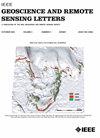An Optimization Approach for Hourly Ozone Simulation: A Case Study in Chongqing, China
IF 4
3区 地球科学
Q2 ENGINEERING, ELECTRICAL & ELECTRONIC
引用次数: 4
Abstract
Continuous spatial knowledge is required to control the regional ozone pollution. Measurements from ground-level sites are beneficial to this goal, but their number is limited due to the huge expenses of site establishment, operation, and maintenance. Remote sensing seems a promising data source, but its application is challenged by bad weather conditions. Always covered by thick clouds, Chongqing, a populated industrial city in west China, is facing serious ozone pollution, but relevant studies here are relatively insufficient. Another alternative is estimating ozone by models. Well-performed models degrade in Chongqing partially due to the very complex terrain. Modeled hourly ozone does not agree with ground-level measurements. Therefore, an optimization approach is proposed to improve model estimates for such regions. This approach integrates the ground-level information (e.g., measured ozone and meteorology) through the employment of ResNet (Residual Network). ResNet overcomes the notorious vanishing gradient issue in classic neural networks, and the ability of learning complex systems is largely boosted. Ozone distribution is like a gray image that varies every second, which is not the case usually learned by ResNet. A color-image alike data structure is raised to address this “nonstill image” problem; according to the Taylor Expansion, polynomials can describe a complex system, and the errors are acceptable. To facilitate the usage in business operations, this approach is designed to be robust, inexpensive, and easy to use. The scheme of control site selection is discussed in detail. In cross-validations, this approach performs well, averaged $R^{2}$ is higher than 0.9 and the error is less than $5 ~\mu \text {g/m}^{3}$ .一种逐时臭氧模拟的优化方法——以重庆市为例
控制区域臭氧污染需要连续的空间知识。从地面站点进行的测量有助于实现这一目标,但由于站点建立、操作和维护的巨大费用,其数量有限。遥感似乎是一个很有前途的数据来源,但其应用受到恶劣天气条件的挑战。重庆是中国西部人口稠密的工业城市,常年阴云密布,臭氧污染严重,但相关研究相对不足。另一种选择是通过模型估算臭氧。在重庆,由于地形非常复杂,性能良好的模型出现了退化。模拟的每小时臭氧与地面测量值不一致。因此,提出了一种优化方法来改进模型对这些区域的估计。这种方法通过使用ResNet(残差网)整合地面信息(例如,测量的臭氧和气象)。ResNet克服了经典神经网络中臭名昭著的梯度消失问题,极大地提高了学习复杂系统的能力。臭氧的分布就像一幅每秒钟都在变化的灰色图像,这不是ResNet通常学到的情况。提出了一种类似彩色图像的数据结构来解决这种“非静止图像”问题;根据泰勒展开,多项式可以描述一个复杂的系统,并且误差是可以接受的。为了方便在业务操作中的使用,此方法被设计为健壮、廉价且易于使用。详细讨论了控制选址方案。在交叉验证中,该方法表现良好,平均$R^{2}$大于0.9,误差小于$5 ~\mu \text {g/m}^{3}$。
本文章由计算机程序翻译,如有差异,请以英文原文为准。
求助全文
约1分钟内获得全文
求助全文
来源期刊

IEEE Geoscience and Remote Sensing Letters
工程技术-地球化学与地球物理
CiteScore
7.60
自引率
12.50%
发文量
1113
审稿时长
3.4 months
期刊介绍:
IEEE Geoscience and Remote Sensing Letters (GRSL) is a monthly publication for short papers (maximum length 5 pages) addressing new ideas and formative concepts in remote sensing as well as important new and timely results and concepts. Papers should relate to the theory, concepts and techniques of science and engineering as applied to sensing the earth, oceans, atmosphere, and space, and the processing, interpretation, and dissemination of this information. The technical content of papers must be both new and significant. Experimental data must be complete and include sufficient description of experimental apparatus, methods, and relevant experimental conditions. GRSL encourages the incorporation of "extended objects" or "multimedia" such as animations to enhance the shorter papers.
 求助内容:
求助内容: 应助结果提醒方式:
应助结果提醒方式:


